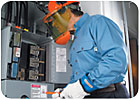
Flame-resistant (FR) protective apparel has improved significantly over the past decade.
Flame-resistant (FR) protective apparel has changed significantly over the past decade. New and recently revised industry standards have driven the development of new technologies in fabric comfort and durability as well as garment designs that can improve employee productivity and corporate image.
All FR fabrics, whether inherently FR or treated to be FR, are engineered to create flame resistance. Some synthetic fibers are actually derived from petrochemicals, but the engineering process makes the fibers flame-resistant. With most natural fabrics, the FR technology takes place after the fabrics are woven and dyed. To the end-user, what matters most is that the FR fabrics retain their flame-resistant performance throughout the entire wear life of the garment.
Many FR fabrics today are actually blends of natural and synthetic fibers. This allows a single fabric to take advantage of the comfort characteristics of the natural fiber and the extra durability offered by synthetics. In addition, because natural-based fabrics are typically heavier than fully synthetic fabrics, the extra weight results in additional thermal insulation, which leads to enhanced protection from electric arc flashes and flash fires while still providing excellent comfort.
FR clothing standards
As mentioned above, several important standards have been introduced or revised over the past decade to address momentary exposures that could turn regular non-flame-resistant clothing into a major additional hazard. Some of the key standards that have been driving end-users into protective clothing programs include the following:
NFPA 70E Standard for Electrical Requirements for Employee Workplaces, 2004 Edition.Originally published in 1979, this standard was updated in 2000 to address FR clothing for protection from electric arc flash exposures for all employees working on or near energized parts and equipment. It has since been updated in 2004 and the next version is due out in 2009. This new standard affects nearly all companies that have employees working on or near energized parts and equipment.
NFPA 70E requires employers to perform a risk hazard analysis to determine the flash protection boundary distance, and it helps them determine the “Hazard Risk Category” and arc thermal performance value (ATPV) needed to protect their employees. Many companies have decided to simply comply to 70E by using “Annex H,” which, in part, includes daily wear FR clothing with an arc rating of 8 or higher.
OSHA 29 CFR 1910.269 Electrical Power Generation, Transmission and Distribution.The electric utility industry started moving into FR clothing in the mid-1990s to comply with this new standard. The majority of utility companies today have some type of protective clothing program; however, some are still operating under the dangerous misperception that heavyweight non-FR cotton is protective.
ASTM F1506 Standard Performance Specification for Textile Materials for Wearing Apparel for Use by Electrical Workers Exposed to Momentary Arc and Related Thermal Hazards.This standard was developed after 1910.269. OSHA has stated that compliance to ASTM F1506 assures compliance to 1910.269. Only flame-resistant fabrics will meet the requirements of 1506.
NFPA 2112 Standard on Flame Resistant Garments for Protection of Industrial Personnel Against Flash Fire (originally published in 2001; the current edition was published in 2007). This is the first standard that addresses FR clothing for employees in industries that have a potential exposure to flash fire, such as petrochemical, chemical, oil and gas. NFPA 2112 has an instrumented mannequin pass/fail test set at 50 percent total body burn (2nd and 3rd degree) when tested for three seconds at 2 cal/cm2 exposure.
Apparel options
With the introduction of these new standards, a rapidly growing number of end-users are investigating the many flame-resistant apparel options for everyday uniform programs. It’s important to consider products that go beyond meeting minimum standards and have a proven history of performing to high FR levels. When considering FR garments, it’s a good idea to seek out testimonials and look for brands that are being specified by other end-users. Once a decision is made on the FR apparel that best fits the needs of your workforce, it’s important to write the FR fabric brand that you have selected in your specification. This will help ensure that an unauthorized fabric change or substitution does not occur months or years into your program.
When investigating clothing options for your flame-resistant protective apparel program, you will benefit from upfront commitment of the time and resources necessary to identify products that can provide your company with the optimum balance of protection, comfort and value. This can ensure that the protective apparel program you design stands the test of time, is met with acceptance by your employees and provides enhanced protection to workplace hazards.